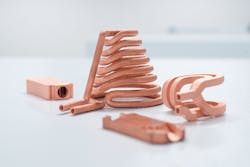Trumpf demonstrates additive manufacturing with copper and gold
DITZINGEN, GERMANY – At the international formnext trade fair that took place November 19-22, 2018, in Frankfurt, Germany, Trumpf demonstrated how the TruPrint 5000 additive manufacturing system, preheated to 500°C, prints high-carbon steel or titanium alloy components that don’t crack or severely warp. The company also has a new green laser with pulse function, enabling pure copper and precious metals to be processed in a 3D printer (FIGURE). Individual unique pieces can be produced on demand while simultaneously saving expensive material.
In 3D printing, tool- and mold-makers frequently work with carbon tool steel 1.2343, an extremely hard and wear-resistant material that dissipates heat particularly well. To date, however, it couldn’t be processed in 3D printers because the components crack during printing. Laser preheating to 500°C lessens the temperature drop following laser melting, preventing fractures in the components.
Preheating also offers major advantages for prostheses and implants produced using additive manufacturing, reducing stresses, improving processing quality, and, in many cases, eliminating the need for support structures. It also often reduces the need for downstream heat treatment, as well as making titanium more resilient and the implants more durable.
Also at formnext, Trumpf used a pulsed green laser to demonstrate how to print pure copper and other precious metals. To achieve this, the developers connected the TruDisk 1020 disk laser with the TruPrint 1000 3D printer. Laser light in the green wavelength spectrum opens up new possibilities for 3D printing—for example, in the electronics and automotive industries.
The green laser is especially lucrative in the jewelry industry because it doesn’t waste expensive gold and silver. Printing is often more economical than milling or casting a piece of jewelry, which inevitably entails a loss of material.
For more information, please visit www.trumpf.com and https://formnext.mesago.com.
